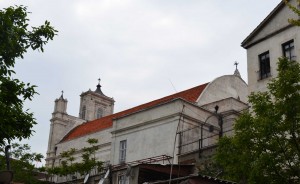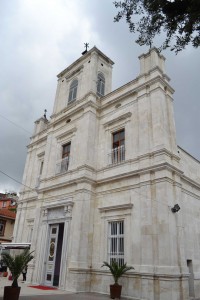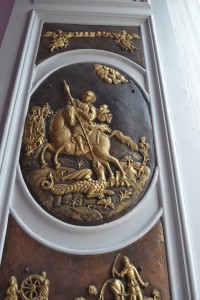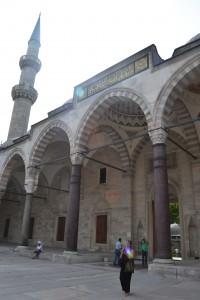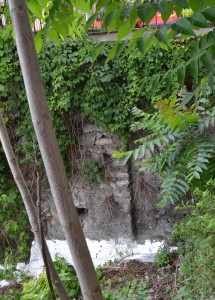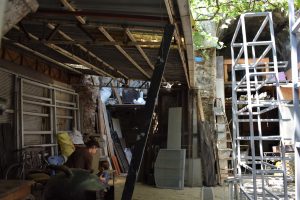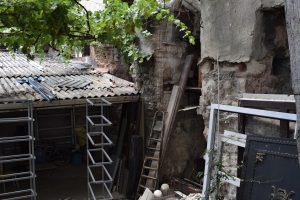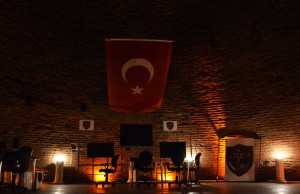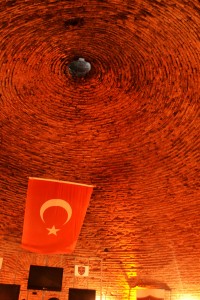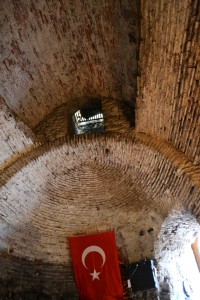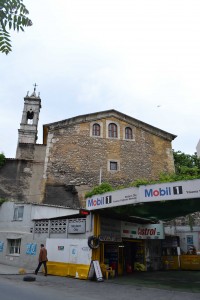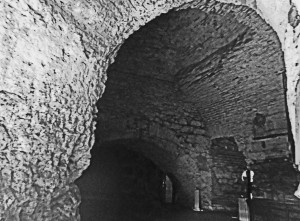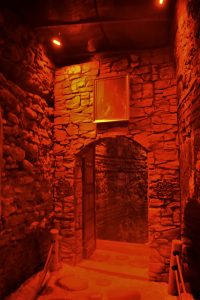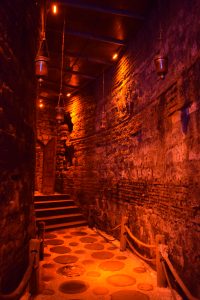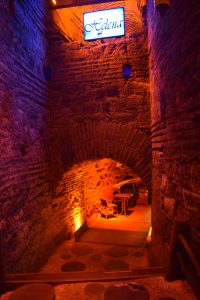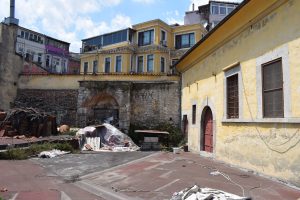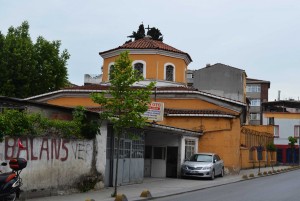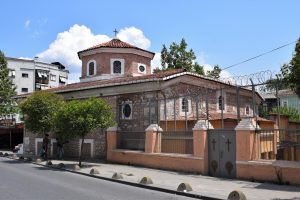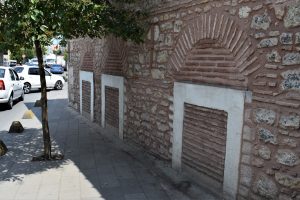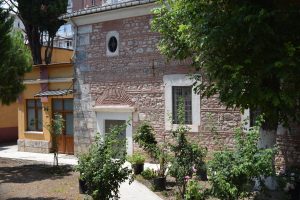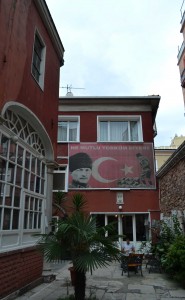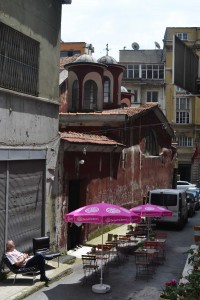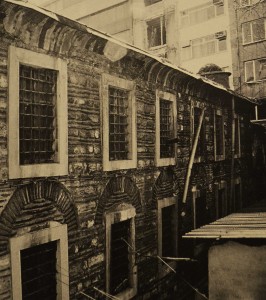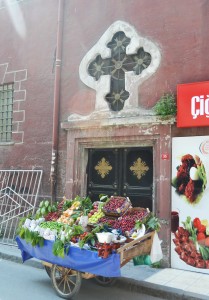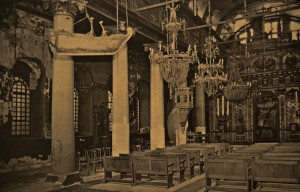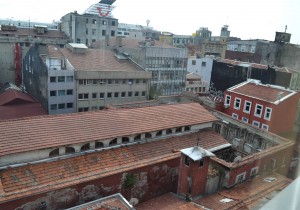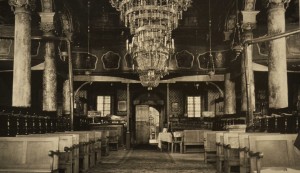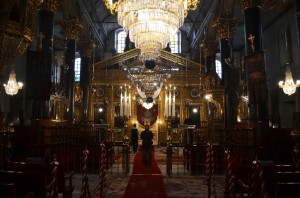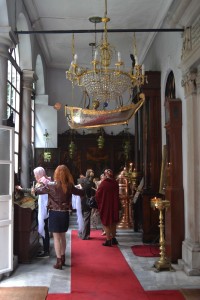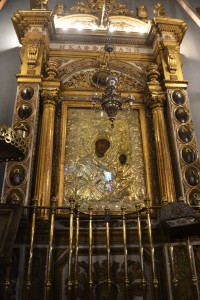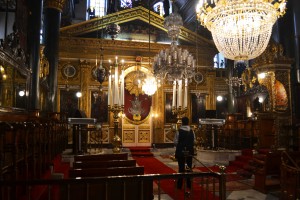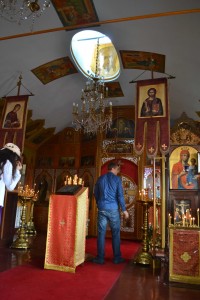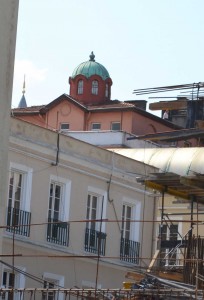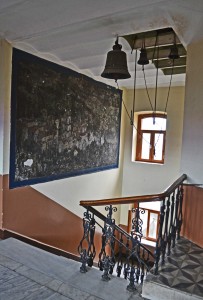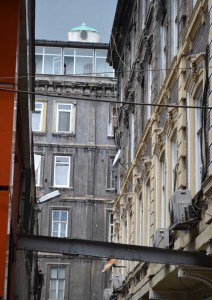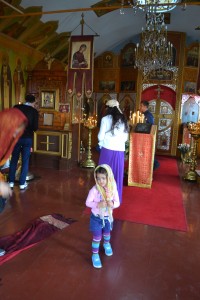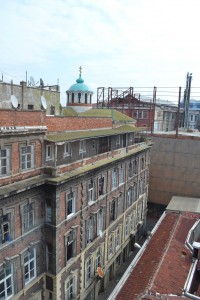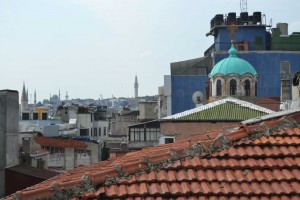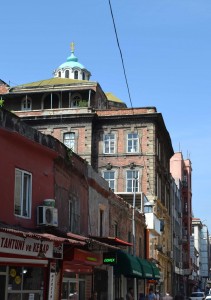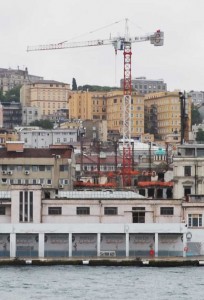The current church is a massive thing from the late 19th century but there was a major monastery here (41.001719,28.932852) from 1031 in which a couple of emperors were buried. The sacred spring (pilgrims still visit the ayazma) seems to have been the reason that the monastery was built here, and the genesis of the Turkish name. The Greek name, Peribleptos, comes from the word for ‘conspicuous’ and refers to the prominent position overlooking Samatya.
Bits of the Byzantine church are here. Mamboury noted that one could see Byzantine foundations from the tram until 1924. These days, one has to hunt among the interesting housing. Fortunately, the inhabitants are interested in what strangers with cameras are doing.
The Byzantine church was a fixture on the pilgrimage trail in late Byzantine times. Gregory of Smolensk, one of the influential Russian travellers of the fourteenth and fifteenth centuries saw fit to make two visits to Peribleptos because of the sheer number of relics that it was necessary to kiss (Majeska (1984) p96). Apparently, the hand of John the Baptist was here during his visit in 1389, rather than at the Hebdomon.
The building appears to have become a Latin Church after the 1204 crusade. This meant that when Michael VIII Palaiologos retook Constantinople in 1261, it no longer had a congregation or upkeep. Consequently, it was available for use by the Armenian population after the Ottoman conquest in 1453. It was the site of the first Armenian Patriarchate, which moved to the current Kumkapı location in 1641. There is a nice story that Sultan Ibrahim had a favourite Armenian concubine, named Şeker Parça (piece of sugar) who weighed 150kg or so and had such influence over him that he was persuaded to transfer ownership of the church from the Greeks to the Armenians in 1643. Unfortunately, there is an authoritative source that recognises the church as Armenian from the 15th century. This is now a pleasant and thriving Armenian centre. The schools on the site have a nice atmosphere and it is good to see the Armenian community in such good condition in Istanbul. The ayazma is open at 10am on Tuesdays.
Some of the columns from the Byzantine Church of St Mary Peribleptes were used in the construction of that vast column museum, the Süleymaniye. I have no idea which ones they are – red porphyry, I believe.
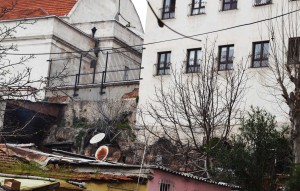
These vaults were mentioned by Mamboury in the 1950s and properly described by Ferudun Özgümüş in 1998
Because the remains of the Byzantine building are limited to the vaults, it is difficult to determine the form of the actual church. Recent studies have compared the configuration of the basement with those of middle-Byzantine churches and come up with a high probability that the Katholikon of the Byzantine Monastery of St Mary Peribleptos was composed of a broad nave with a central octagonal section supporting a large dome on squinches. This is larger than previous reconstructions suggested, and more congruent with descriptions from contemporary pilgrims, especially the excellently named Ruy Gonzales de Clavijo who visited in 1403.
As of July 2019, the vaults are occupied by a welder and family.
The plaster continues to flake off and reveal more of the lovely stonework.
Ball, A, “Peribleptos Monastery”, 2008, Encyclopaedia of the Hellenic World, Constantinople Available online at: http://www.ehw.gr/l.aspx?id=12325 Accessed 10th Aug 2016
Dark, K., “The Byzantine church and monastery of St. Mary Peribleptos in Istanbul,” The Burlington Magazine 141.2 (Nov. 1999), pp. 656-7
Majeska, Robert P. (1984): Russian travellers to Constantinople in the 14th and 15th Centuries.Dumbarton Oaks, Washington D.C.
Mamboury, E (1925) Constantinople: Tourists’ Guide, 1st edition. Rizzo and Son, Constantinople.
Mamboury, E (1951): Istanbul Touristique. Çituri Biraderler Basımevi, Galata.
Mango, C. (2002) “The monastery of St. Mary Peribleptos (Sulu Manastır) at Constantinople revisited,” Revue d’Études Arméniennes 23, pages 474, 489.
Mathews, T and Ö Dalgıç (2016) A New Interpretation of the Church of Peribleptos and its Place in Middle Byzantine Architecture. 4. Uluslararası Bizans Arıştırmaları Semposyumu. Abstract Available at: http://sgsymposium.ku.edu.tr/symposium/abstracts-of-papers2007/thomasfmathewsorgudalgic Accessed 10th Aug 2016
Özgümüş, F. (2000) ‘Peribleptos (Sulu Manastır) in İstanbul’, Byzantinische Zeitschrift 93/2. pages 508-520.
Vin, J.P.A van der (1980) Travellers to Greece and Constantinople: Ancient Monuments and old traditions in Medieval Travellers’ Tales. Nederlands Historisch Archaeologisch-Instituut te Istanbul. Available online at http://www.nino-leiden.nl/doc/PIHANS049.pdf

Posted June 28, 2014 Posted by Adam in Uncategorized
Only the crypt remains but it is an amazing piece of brickwork. It is underneath the Church of St Menas (41.00033,28.93202), almost directly across the road from St George of the Cypresses and in an area of Samatya with an unfeasibly high concentration of churches. In the 1990s, it was used as a workshop. The Mobil car service place (Modern Oto) used to be the point of entry. When I went there in 2014, the lovely old couple in the office at the back explained that they used to be able to let people through from there but some decades ago the entrance was blocked up. I decided to hang around the doors on the street frontage, looking suspicious and taking useless photos. Sure enough, after ten minutes, two young men turned up to ask me what I was doing. At first they denied that it had been a church. Eventually, they unlocked the doors and let me in.
The place has had a bit of a transformation. The gorgeous brick dome that looks like the tomb of Atreus is looking better than ever. The space is being used to show films at the moment. The plan is to open it as a café in 2015 but official permission is slow in coming. In the meantime, it is one of the most beautiful buildings in Istanbul.
Van Millingen didn’t know of this crypt as it was only rediscovered in the 1930s. It seems to date from the 5th or 6th century.
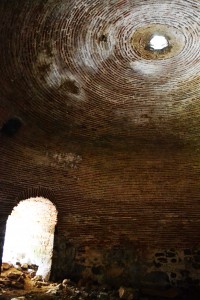
As a comparison, here is the interior of the dome in one of the towers in the fortress at Rumeli Feneri
The ambulatorio (closed passage around the outside of the church) did open as a cafe in October 2015. Unfortunately, government regulations mean that the Byzantine sections cannot yet be opened to the public. This has given rise to the ridiculous phenomenon of this cafe inside a beautiful and significant structure being wood-panelled and draped in cloth so the brickwork cannot be seen. Pictures are provided to give the connoisseur some idea of what he or she is inside.
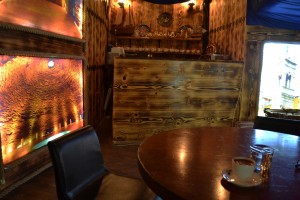
Turkish coffee in hidden splendour
The barista (who makes only çay and really good Turkish coffee) said that the martyrium will be open for business in February 2016, inşallah.
It isn’t. In June 2016, the kahvehane appears to have closed.
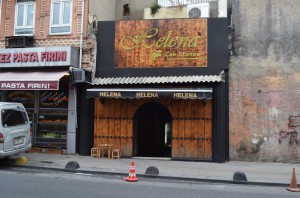
Currently a loss-making concern
This reference is the most comprehensive recent guide to the martyrium that I can find:
Beygo, A. (2005) Istanbul Samatya’da Karpos Papylos Martyrion’u. Yüksek Lisans Tezi, Istanbul Teknik Üniversitesi, Fen Bilimleri Enstitüsü. Available online at: https://polen.itu.edu.tr/bitstream/11527/7118/1/3687.pdf Accessed 21st June 2016
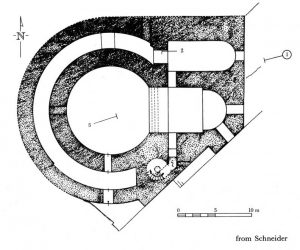
This plan of the martyrium comes from Thomas Matthews’ site: http://www.nyu.edu/gsas/dept/fineart/html/Byzantine/
The café is in the ambulatory, the almost circular passage around the outside of the structure. The theatre/cinema section is in the central room. The entrance to that section is into the apse, in the south-east of the building.
This reference is the most comprehensive recent guide to the martyrium that I can find:
Beygo, A. (2005) Istanbul Samatya’da Karpos Papylos Martyrion’u. Yüksek Lisans Tezi, Istanbul Teknik Ãœniversitesi, Fen Bilimleri Enstitüsü. Available online at: https://polen.itu.edu.tr/bitstream/11527/7118/1/3687.pdf Accessed 21st June 2016
Matthews, Thomas (2001):Â The Byzantine Churches of Istanbul. Institute of Fine Arts, New York University. Available athttp://www.nyu.edu/gsas/dept/fineart/html/Byzantine/
Good news… as of July 2019 Helena Stones is back in business.
The proprietors seem to spend their Sundays doing maintenance, particularly electrical work.
The churchyard of St Menas is the roof of the martyrium.

Posted June 28, 2014 Posted by Adam in Uncategorized
There must be some Byzantine bits remaining but they are underground now. As with St Mary of the Mongols, this is a church as it was before the Ottoman conquest. However, the Byzantine structure burned down in a fire in 1782. After reforms in the early 19th century, it was permitted to build churches with domes. Hence the 1832 rebuild was in the form that we see it now. It’s nice to see that at least one of the cypresses planted recently has reached a decent height. (41.000848,28.933364)
The church has been refurbished recently. Here are the results in July 2019.
The yellow-painted plaster has been removed and the newly exposed stonework is in fine condition.
This view of the arches facing the main Samatya road show how much the level of the land around the church has risen in a couple of hundred years.
Some of the attendant buildings retain the distinctive yellow plaster. It is promising to see such a comprehensive restoration in an area bristling with Orthodox churches. This seems to go against the trend of slow disintegration that characterised the last century of neglect of Samatya’s churches.

Posted June 28, 2014 Posted by Adam in Uncategorized
What can you call the Autocephalous Türk Orthodox Church? A nonentity, a grand theft, an anomaly, a political expedient – they all apply. Formed in 1922 in the nationalist euphoria after the eviction of the Greek army, Pavlos Karahisarithis decided that he was the Patriarch Papa Eftim and formed the Autocephalous Patriarchate of Anatolia. He repeatedly invaded the Greek Orthodox Patriarchate in Fener with his supporters. In 1924, he made the politically astute decision to carry out church services in Turkish. He changed his name to Zeki Erenerol and managed to gain a reasonable amount of support from elements of the new republican government. He was given the Church of Meryem Ana in Galata as his headquarters. There were few Greeks remaining in the city after the enforced population exchange and the Erenerols were exempted from exile.
With few Christians left in Turkey and those who stayed deciding to remain affiliated with the Greek Patriarchate, Papa Eftim had difficulty in gaining and maintaining a congregation. In the 1930s, some 70 Garguaz – Christian speakers of a Turkish dialect who lived in Bessarabia – were offered a deal to settle in the Marmara area and become part of the Türk Orthodox Church. Within a few years, they had converted to Islam and left Eftim with no followers. This and subsequent efforts to attract adherents from what could be seen as the wider Turkish community gained the church support from right-wing nationalists. The most prominent member of the Erenerol family, the only people who can remotely be considered as Türk Orthodox, is Sevgi Erenerol. She is serving a life sentence in prison for her enthusiastic participation in the Ergenkon conspiracy, the ultranationalist network of assassins, warlords, politicians and generals that controlled Turkish affairs in the late 20th century. This site from 2008 details one version of the connection between Ergenekon and the Türk Orthodox Church.
Church services ended in 2008 after the widespread allegations that the church had served as a sort of headquarters for Ergenekon. They began again at some stage and by the time this article was published, attendance on Sundays had risen to a congregation of two Erenerols. To give some idea of the incestuous nature of the Turk Orthodox Church, Sevgi Erenerol is the granddaughter of the first Patriarch, the niece of the second, the daughter of the third and the sister of the fourth.
The Patriarchate is the rather lovely Church of Meryem Ana in Karaköy (41.025099,28.978889). This was founded by the Greek Orthodox community of Kaffa (Crimea) and was hence named Santa Maria de Kaffa or Panagia Kaphatiani. Its courtyard bears a prominent banner saying ‘Ne Mutlu Türküm Diyene’. This means ‘happy is the person who says I am a Turk’. This is a nationalist slogan from the early republican era. This is usually written in whitewashed rocks on mountains overlooking Kurdish villages by Turkish conscripts to tell the Kurds that they don’t exist. Here it is written to tell the Greeks that they should be Turks. Fairly obviously, the Ecumenical Patriarchate has never recognised the existence of the Türk Orthodox travesty and still sees the churches as being Greek Orthodox.
The Church of St Nicholas (Aziz Nikola) taken over by Papa Eftim after the 1955 anti-Greek riots. It was damaged in the earthquake of 1999 and is closed for repair. It is partly roofless in May 2014 and looks very sad (41.024482,28.978283). With no congregation and no likelihood of the Erenerol family loosening their hold on this ceremonial ruin, it looks as if it will slowly crumble into the earth.
The Church of Saint John (Aya Yani or Aziz Yahya 41.02507,28.978018) was also taken over by the Türk Orthodox Patriarchate after the riots. Obviously, there was no congregation to fill it so it was rented to the Assyrian Church for a while. I’m not sure whether anyone is using it at the moment. Some sources give the dedication of this church as St John Chrysostomas, others as St John the Baptist (Karaca, Freely). It may have been a politically motivated change in dedication. The Divine Liturgy of John Chysostom is the standard service of the Greek Orthodox community and much importance is given to its exact wording. Clearly, saying the liturgy in Turkish language would mean John Chrysostom’s liturgy no longer being used. Changing the dedication to the better-known and less controversial John the Baptist may have avoided some issues in the Orthodox community.
This final story sums up the Türk Orthodox charade. In 1926, the patriarch took over the Church of Christ. In 1947, the Turkish government announced that the church was to be returned to the Greek Orthodox community. Unfortunately, a road was widened and the church was demolished. Compensation was paid to the Türk Orthodox Patriarchate.
On the first Sunday in October (2014), I was breakfasting in the excellent OPS Cafe just opposite the Patriarchate when I heard the bells of the Panaghia Kaphatiani. For the first time, I found the church open and the atmosphere of a normal church prevailed. There were people lighting candles and praying before the altar and priests preparing the host. When the service got under way, there were seven women in the congregation. Several of them were young and giggly, as if this was their first time in church. The liturgy was conducted by four ecclesiastical personnel. It was odd to hear the ritual spoken in Turkish. Still, it was a genuine church service in a church that all sources had led me to believe was defunct. I’ll go and talk to the caretaker in the near future to find out what is happening in the world of the Türk Orthodox Church.
Posted June 28, 2014 Posted by Adam in Uncategorized
Within 100 metres of each other, on top of the large warehouses in the Karaköy area, perch the domes of four Russian chapels – dedicated respectively to St Panteleimon (41.024749,28.978425), the prophet Elias (41.024447,28.97806), St Andrew (41.024613,28.978785), and the Holy Trinity (41.024787,28.979037). These were built between 1870 and 1880 to cater for Russian pilgrims breaking their sea journeys on the way to Mount Athos, or sometimes Jerusalem. There were dormitory rooms for the pilgrims in the buildings beneath the churches. The Holy Trinity chapel is now abandoned, although the dome is in surprisingly good repair. St Panteleimon is still staffed but is damp and peeling. Aya İliyas (The Chapel of the Prophet Elias/Elijah) has extensive frescoes painted in about 1900 by artists from Mt Athos. These are now looking fairly awful because of damp and lack of money for maintenance. There was a service held here in 2013. St Andrew had a restoration in preparation for a service of major importance held in 2011.
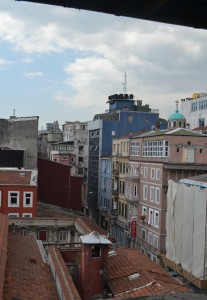
Church of the Prophet Elias from the balcony of the Church of St Andrew. Aziz Nikola in the foreground.
There are very good reasons for these recent one-off celebrations of mass. There is only one priest associated with the four Karaköy Russian churches. He is very old but has enormous energy. I met him in May 2014 and was impressed with the fighting spirit that he shows on behalf of his church (St Panteleimon). The community has called on the Russian Orthodox patriarchate to supply more priests. However these churches, despite being Orthodox and serving a Russian community, are not really Russian Orthodox. During the heyday of the churches, inevitably coinciding with the influx of Christians from the new Soviet Union just after the 1917 revolution, the churches’ links with the struggling Russian Orthodox Church dwindled. The churches came under the jurisdiction of the Mt Athos monasteries that provided their raison d’etre. These monasteries are, in turn, administered by the Greek Patriarchate in Constantinople.
The value of real estate in Karaköy is rising fast. The hans are not profitable. Until recently, they have been classified as commercial buildings. The contract for the development of Galataport, the reconstruction of the waterside area in Karaköy, is worth an enormous amount of money. There is no bar to demolition by developers of a building zoned as commercial. This explains the importance of services held in the churches of St Andrew and the Prophet Elijah in the last few years. If the churches can be shown to be active places of worship, there is a possibility, a very small possibility, of the buildings being saved. The Greek Patriarchate provided personnel to conduct the services. At the moment, the churches of St Andrew and the Prophet Elijah are in the best condition that they have been for over forty years. They are still permanently locked and it seems most unlikely that they will survive development that carries a financial incentive approaching a billion US dollars.
For now, St Panteleimon is the only church open for regular Sunday worship. Catch it now. In fact, turn up with vast numbers of your friends every Sunday for the foreseeable future. That may be the only way to give the survival of this fragile piece of Russo-Turco-Greek history any chance.

« Previous Entries Next Entries »
